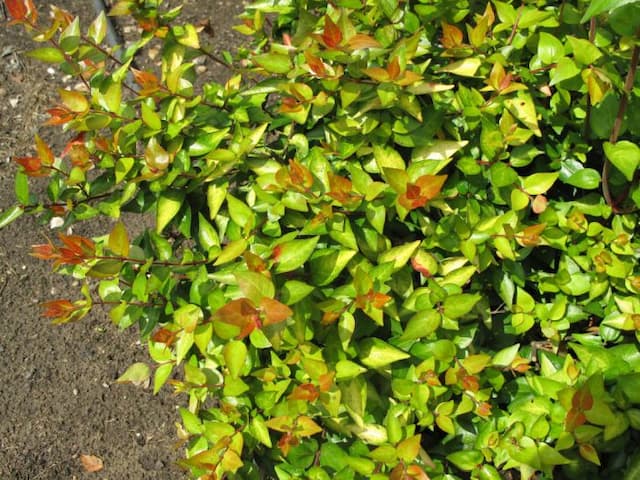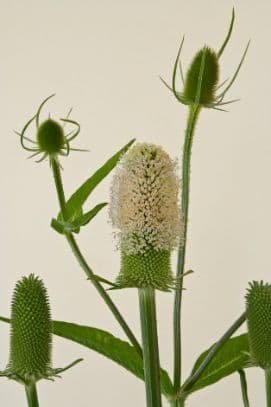Etruscan Honeysuckle Lonicera etrusca 'Michael Rosse'

ABOUT
Lonicera etrusca 'Michael Rosse', more commonly known as the Italian Woodbine or Etruscan Honeysuckle, is a cultivar celebrated for its ornamental qualities and fragrant flowers. This perennial vine boasts a lush foliage of oval-shaped leaves that are a bright, vibrant green. The plant is particularly noted for its striking flowers, which bloom profusely in a trumpet-like shape, displaying a beautiful array of colors usually ranging from creamy white to pale pink or yellow. These flowers are often two-toned, with the outside of the trumpet exhibiting a different hue to the inside, and are cherished for their delightful scent which can enhance the sensory appeal of any garden or landscape. Following the bloom period, the Italian Woodbine produces an array of red to black berries, which can attract birds and other wildlife. Overall, this plant contributes both visual and olfactory charm to its surroundings.
About this plant
 Names
NamesFamily
Caprifoliaceae.
Synonyms
Etruscan Honeysuckle, Italian Honeysuckle, Mediterranean Honeysuckle.
Common names
Lonicera etrusca 'Michael Rosse'.
 Toxicity
ToxicityTo humans
The Lonicera etrusca 'Michael Rosse', commonly known as the Etruscan honeysuckle, is not typically listed as a highly toxic plant to humans. However, many species within the honeysuckle family do contain saponins and glycosides which can be mildly toxic when ingested in significant quantities. Symptoms of poisoning may include stomach upset, diarrhea, and vomiting. It is generally recommended to avoid ingesting this plant particularly if you do not have knowledge of its edibility and potential effects.
To pets
The Etruscan honeysuckle is not commonly known to be highly toxic to pets, but as with humans, plants in the honeysuckle family can contain compounds such as saponins that might cause mild gastrointestinal upset if ingested in large amounts. Symptoms in pets may include vomiting, diarrhea, and abdominal pain. While not typically lethal, it is wise to prevent pets from consuming this plant to avoid any potential discomfort or more severe reactions.
 Characteristics
CharacteristicsLife cycle
Perennials
Foliage type
Semi-deciduous
Color of leaves
Green
Flower color
Yellow
Height
6-10 feet (1.8-3 meters)
Spread
5-6 feet (1.5-1.8 meters)
Plant type
Climber
Hardiness zones
7
Native area
Mediterranean
Benefits
 General Benefits
General Benefits```html
- Aesthetic Appeal: Lonicera etrusca 'Michael Rosse', commonly known as Honeysuckle, adds visual interest to gardens with its vibrant flowers and lush foliage.
- Attracts Pollinators: The fragrant blooms attract bees, butterflies, and other beneficial pollinators, supporting biodiversity.
- Fast Growth: Honeysuckle is known for its rapid growth, quickly covering trellises, walls, or fences for privacy or decorative use.
- Low Maintenance: Once established, Honeysuckle requires minimal care, making it suitable for a wide range of gardeners.
- Hardy Nature: Honeysuckle is resilient and can thrive in various climates, often tolerating poor soils and drought conditions.
- Erosion Control: The plant's extensive root system can help stabilize soil and prevent erosion on slopes or banks.
- Fragrance: The sweet scent of Honeysuckle flowers can add a pleasant fragrance to gardens or patios.
- Wildlife Habitat: The dense foliage provides nesting sites and shelter for birds and small wildlife.
- Seasonal Interest: Honeysuckle offers long blooming periods, providing seasonal interest from late spring to early autumn.
 Medical Properties
Medical PropertiesThis plant is not used for medical purposes.
 Air-purifying Qualities
Air-purifying QualitiesThis plant is not specifically known for air purifying qualities.
 Other Uses
Other Uses- Lonicera etrusca 'Michael Rosse', commonly known as Italian Honeysuckle, can be used in basket weaving due to its long, flexible stems.
- The twining nature of Italian Honeysuckle makes it an ideal living support for growing espaliered fruit trees or ornamental vines.
- The flowers of Italian Honeysuckle can be floated in bowls of water as a decorative feature for outdoor garden parties or events.
- Italian Honeysuckle can be trained along fences or pergolas to create green privacy screens that also offer a sweet fragrance.
- The plant can act as a ground cover in large garden areas to help suppress weeds and reduce garden maintenance.
- When dried, the branches of Italian Honeysuckle can be used in creating naturalistic art pieces or rustic home decor accessories.
- The dense foliage can provide a natural habitat for beneficial insects and small wildlife, promoting biodiversity in the garden.
- Italian Honeysuckle can be used in the production of natural dyes for fabrics, though the specific coloration properties would need experimentation.
- The plant's ability to grow in challenging conditions makes it suitable for erosion control on slopes or riverbanks.
- Gardeners sometimes use Italian Honeysuckle as a decoy plant to attract aphids and protect more valuable plants from infestation.
Interesting Facts
 Feng Shui
Feng ShuiThe plant Lonicera is not used in Feng Shui practice.
 Zodiac Sign Compitability
Zodiac Sign CompitabilityThe plant Lonicera is not used in astrology practice.
 Plant Symbolism
Plant Symbolism- Devotion: The most common name of Lonicera etrusca 'Michael Rosse' is Etruscan honeysuckle. Honeysuckles are often associated with devotion due to their twining vines that represent the tight bond in relationships.
- Affection: Etruscan honeysuckle's sweetly-scented flowers are symbolic of affection and the pleasure of companionship, reminiscent of how their pleasant fragrance attracts pollinators and people alike.
- Generosity: The abundant nectar of honeysuckle flowers symbolizes generosity, indicating the plant's willingness to share its sweetness and value with the surrounding environment.
- Fertility: As honeysuckles are vigorous growers, they symbolize fertility and the fruitful multiplication of life’s aspects, whether in family, ideas, or projects.
 Water
WaterThe Etruscan honeysuckle should be watered deeply, allowing the water to seep down to the roots, rather than just wetting the surface. Generally, you should water it once a week, but this may need to be adjusted based on weather conditions. During the hot, dry summer months, it may require watering twice a week, providing about 1-2 gallons per session, depending on the size of the plant. In contrast, during cooler months or rainy periods, the frequency should be reduced. Always check the soil moisture level to avoid waterlogging, which can lead to root rot.
 Light
LightEtruscan honeysuckle thrives best in full sun to partial shade conditions. It prefers a spot where it can receive at least 4-6 hours of direct sunlight daily, which encourages abundant flowering and healthy growth. However, in regions with intensely hot summers, some afternoon shade can help protect the plant from excessive heat stress.
 Temperature
TemperatureEtruscan honeysuckle is versatile and can tolerate a range of temperatures, but it grows best when the temperature is between 60°F and 80°F. This plant can survive minimum temperatures down to around 20°F, making it suitable for many temperate regions. During extreme cold spells, providing some protection or mulch can help ensure the plant's survival.
 Pruning
PruningPrune Etruscan honeysuckle to maintain shape and encourage vigorous growth. The best time to prune is in the late winter or early spring, just before new growth starts. It is often sufficient to prune once or twice a year, cutting back the plant to remove dead or weak stems and to shape the plant. Pruning not only stimulates new growth but also enhances air circulation within the plant, which can reduce the incidence of fungal diseases.
 Cleaning
CleaningAs needed
 Soil
SoilThe Etruscan honeysuckle ('Michael Rosse') thrives best in well-draining soil enriched with organic matter, such as a mix of loam, peat, and sand. The soil pH should be slightly acidic to neutral, ranging between 5.5 and 7.0 for optimal growth.
 Repotting
RepottingEtruscan honeysuckle should be repotted every few years to replenish the soil and accommodate root growth. Check annually, and repot if roots are circling the container or it becomes root-bound.
 Humidity & Misting
Humidity & MistingEtruscan honeysuckle prefers moderate humidity levels but is adaptable to different environmental conditions as long as it is not extreme dryness.
 Suitable locations
Suitable locationsIndoor
Place in bright, indirect light and ensure good air circulation.
Outdoor
Plant in full sun to partial shade; shelter from harsh winds.
Hardiness zone
6-9 USDA.
 Life cycle
Life cycleLonicera etrusca 'Michael Rosse', commonly known as the Etruscan honeysuckle, begins its life as a seed which, upon germination in favourable conditions of warmth and moisture, sprouts roots and a shoot. The shoot grows into a young vegetative plant and, provided with ample sunlight and water, it develops into a mature plant with distinctive twining stems and oval leaves. During its growth, it will develop buds that bloom into fragrant, two-lipped, creamy yellow to pink flowers, typically in the late spring and summer, attracting pollinators such as bees and hummingbirds. Following pollination, these flowers eventually give way to red or black berries, which contain seeds that can disperse to produce new plants. The Etruscan honeysuckle is a perennial, which means it can survive multiple seasons, often dying back in winter, especially in colder climates, before resuming growth from its rootstock in spring. Throughout its lifespan, which can extend for many years, it requires pruning to manage its vigorous growth and maintain a desirable shape.
 Propogation
PropogationPropogation time
Spring-Early Summer
Lonicera etrusca 'Michael Rosse', commonly known as the Italian honeysuckle, is best propagated by softwood cuttings. The ideal time for this method is late spring to early summer, when new growth is mature enough yet still in the softwood stage. To propagate, select a healthy, non-flowering shoot and cut a 4 to 6 inch (approximately 10 to 15 cm) piece just below a leaf node. Remove the leaves from the lower half of the cutting and dip the cut end into rooting hormone powder to encourage root growth. Then, insert the cutting into a pot filled with a mixture of peat and perlite or sand to provide good drainage and support. Keep the cutting moist and in a warm, shaded environment until roots develop, which typically takes a few weeks, after which it can be transferred to a bigger pot or into the garden.








